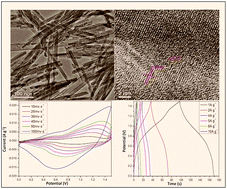Ultra-small and low crystalline CoMoO4 nanorods for electrochemical capacitors
Abstract
Molybdenum and cobalt binary oxide (CoMoO4) nanowires, nanorods and micro-rhombohedra were synthesized by facile hydrothermal/solvothermal methods. Of all the structures, the ultra-small nanorods showed pseudocapacitive nature, high coulombic efficiency, and the best overall performance as compared to the other electrodes, with a maximum specific capacitance of 420 F g−1 at 1 A g−1. Besides, the rate capability and galvanostatic cycling test revealed their good rate capability and cycling stability. More importantly, the CoMoO4 nanorods and a pure graphene hydrogel were used to assemble an asymmetric electrochemical capacitor, which exhibited improved power density and energy density when compared to the performances of some transition metal oxide based full cells. CoMoO4 nanorods possess large specific capacitance, rate capability and long-term performance. The enhanced electrochemical behaviors of nanorods show that controlling the nano-architecture and crystallinity could be a simple and effective strategy to boost electrochemical energy capacitive capabilities.


 Please wait while we load your content...
Please wait while we load your content...